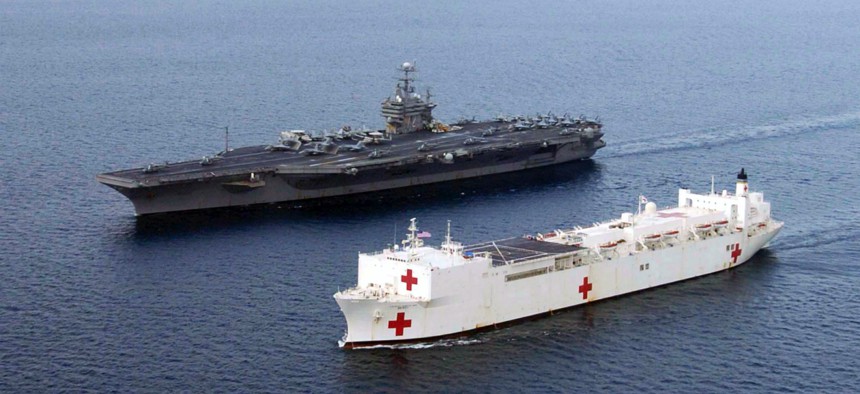
In 2005, USNS Mercy (T-AH 19) and USS Abraham Lincoln (CVN 72) were dispatched to Indonesia for Operation Unified Assistance, the humanitarian relief effort to aid the victims of the recent tsunami. U.S. Navy photo by / grapher's Mate 3rd Class Gabriel R. Piper
The US Navy Can, and Should, Do More Against the Coronavirus
Aircraft carriers and big-deck amphibious ships can help — as they have often done in humanitarian-relief efforts overseas.
The nation will soon need far more hospital beds and medical capacity than it has — just how much more depends on how well our collective social distancing efforts work. U.S. Navy officials announced last week that they will send two hospital ships to provide relief to U.S. medical facilities that will soon be overwhelmed by the COVID-19 pandemic. The USNS Comfort will assist New York City, while the USNS Mercy will head to Los Angeles. Each of these massive floating hospitals brings roughly 1,000 beds, 12 operating rooms, a pharmacy, and a sizable medical laboratory. They will not be used to treat coronavirus patients, but to provide other types of care in order to ease the rising burden on shoreside hospitals. Given the magnitude of the impending medical crisis and shortage of hospital beds, this response will barely make a dent – but every dent will save lives.
Yet the hospital ships are not the only way the Navy can, and should help. In addition to the hospital ships, leaders should consider putting aircraft carriers and other large amphibious vessels to this use.
Combining mobility, versatility, and capacity with a ready and capable workforce, these ships have historically proven invaluable during times of unexpected crisis and are well suited for rapid, flexible response. The question the acting Navy Secretary should be asking himself is not whether he should deploy more ships to provide relief to the medical community, but how many combat vessels he should apportion for this response and how many he should leave prepared for unexpected combat operations.
Related: US Navy Working to Keep Subs and Destroyers From Becoming COVID-19 Hotspots
Related: Coronavirus Halts Military Travel In and Out of Iraq and Afghanistan
Related: The Prognosis: Latest News on Coronavirus & National Security
Throughout my 20-year naval career, I’ve witnessed the aircraft carrier quickly adapt to perform a variety of missions without notice or preparation. In response to the catastrophic earthquake and tsunami in the Indian Ocean in 2004, DoD established Joint Task Force 536 to coordinate assistance across services. The Navy provided 29 ships for 81 days. When Hurricane Katrina devastated New Orleans in 2005, the Navy responded with 34 vessels for 42 days. During Operation Tomodachi following the 2011 earthquake, tsunami, and subsequent nuclear crisis in Japan, the Navy provided 24 ships for 54 days. Each of these crises – and many others – required an adaptive and flexible response.
The Navy has called upon the brave men and women aboard aircraft carriers and other large vessels extensively to conduct unexpected humanitarian assistance and disaster relief, or HADR, around the globe. Often, crews conduct such missions alongside of – and in coordination with – hospital ships and other large vessels. They have risen to each challenge to provide critical assistance during dire times. They are prepared and able to answer that call today.
Rather than exposing the crews to the risk of infectious disease aboard a ship, the Navy currently plans to use the Comfort and Mercy for their trauma care capability and large capacity to ease the medical burden on hospitals treating COVID-19 patients. Aircraft carriers and large deck amphibious ships are well suited to do the same. With a crew of more than 6,000 sailors – including six medical officers, one operating room, three ICU beds, 52 ward beds, a medical laboratory, and a pharmacy – aircraft carriers are already configured to provide outstanding medical support for warfighting.
Fixed-wing aircraft and personnel assigned to the air wing – slightly under a third of the total manning on an aircraft carrier – would not be required to support this mission, so they could be left at home, freeing up berthing and space for medical personnel, equipment, and additional helicopters. The three large hangar bays could be divided and closed off to support hundreds of hospital beds. Large amphibious ships that are designed to move combat personnel and equipment – such as LHDs and LHAs along with the smaller LSDs and LPDs – have similar medical capabilities with less capacity than the aircraft carrier. All are good candidates for rapid and flexible response.
The time to ask whether or not the Navy is prepared for a war such as this is over. The time to adapt and respond is now. Leaders must learn from the unfolding crisis in Italy, understand the projections, and recognize the impending tidal wave of demand that our medical facilities will face in the coming weeks and months. While our nation’s medical staff, social workers, and first responders are on the front lines, the Navy needs to figure out how it can get in the fight. This global pandemic is unlike anything we have experienced in a generation. It will require a different response than ever before. I am confident that our sailors and Marines will answer the call — a call that their leaders should issue promptly.
The views expressed herein are those of the author and do not reflect the official policy or position of the U.S. Navy, U.S. Department of Defense, or the U.S. government.



